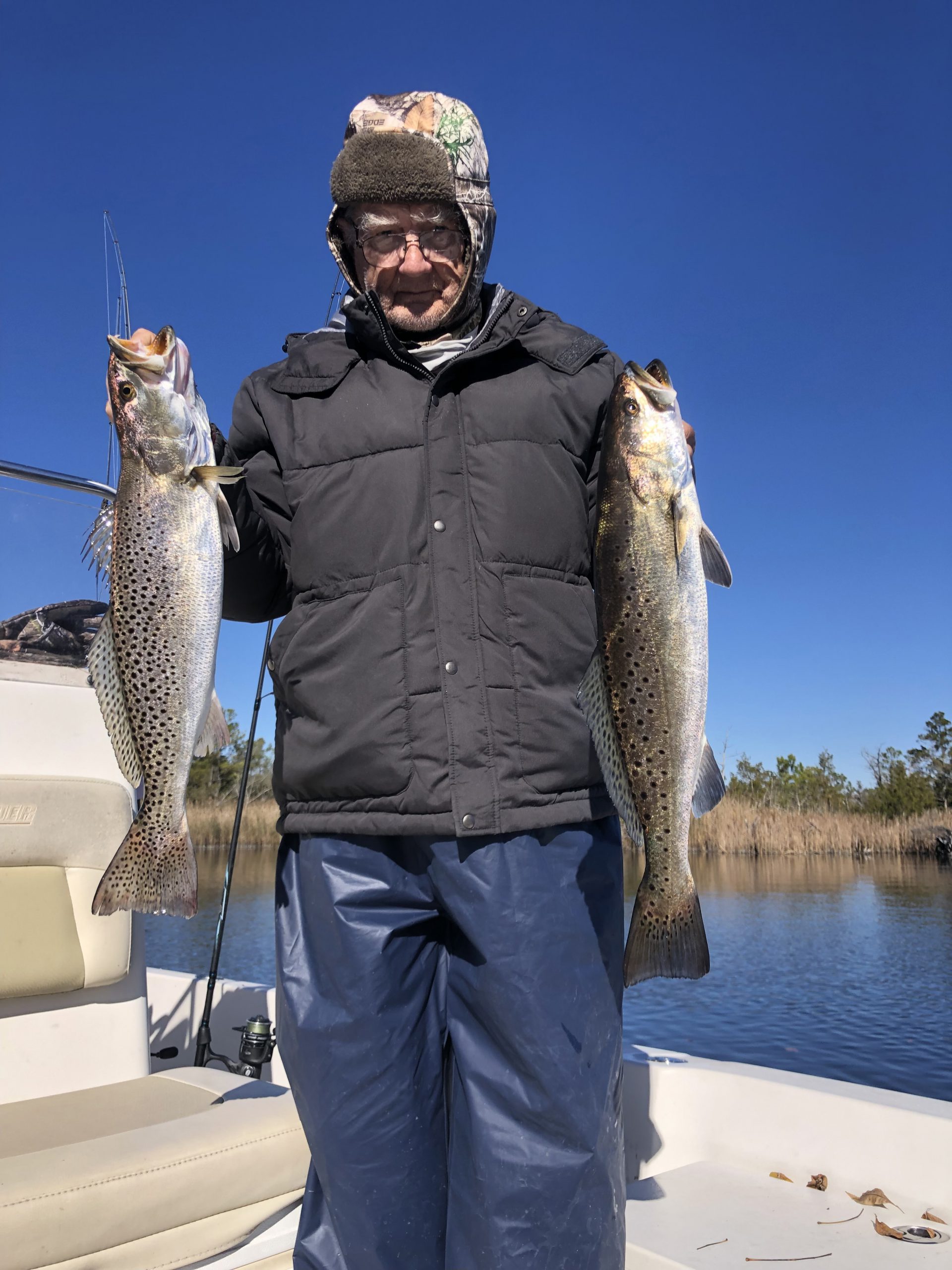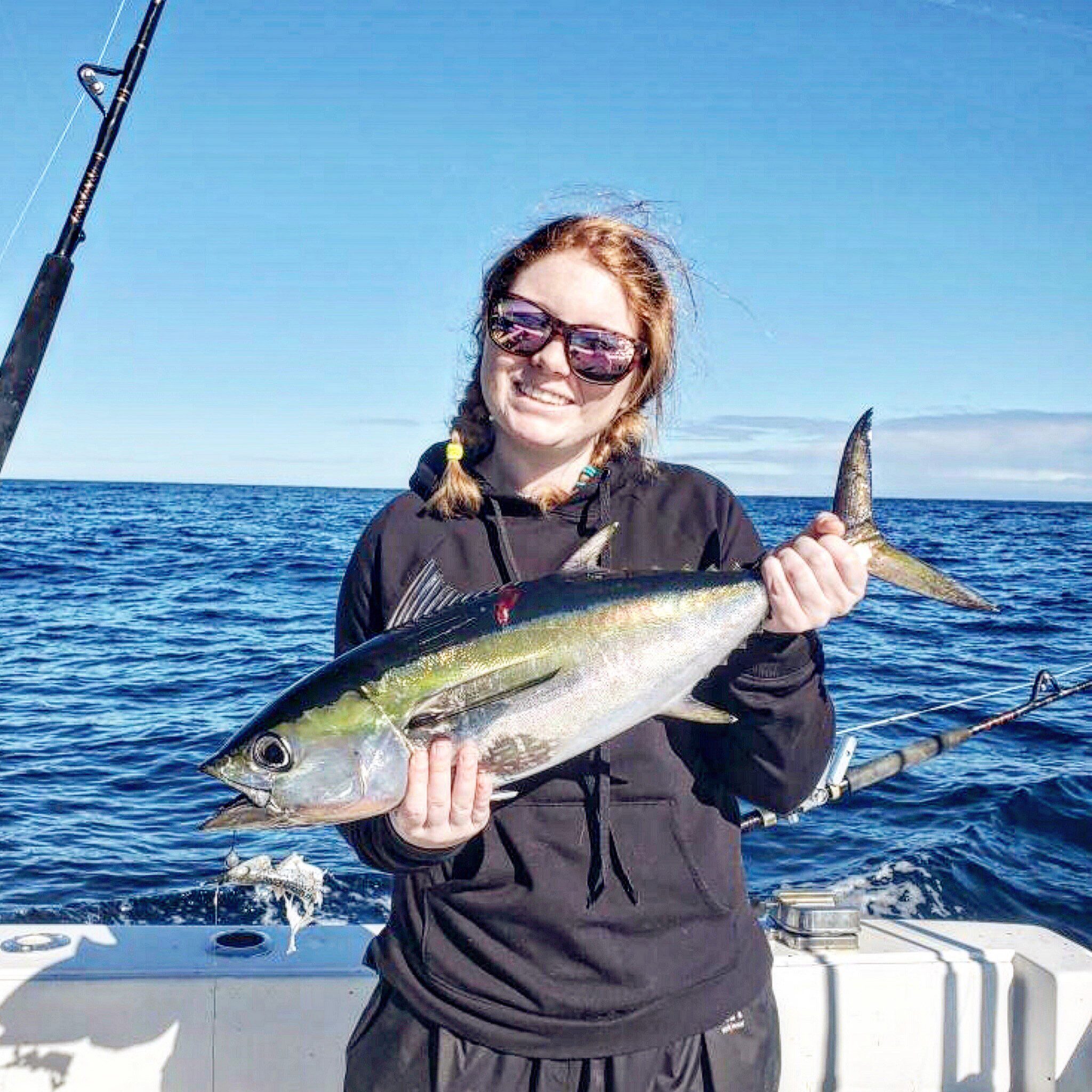Swansboro/Emerald Isle – March 2022
Randy, of The Reel Outdoors, reports that surf anglers are finding some nice-sized red drum while sight casting at schools in holes up and down the beach.
There is also plenty of red drum action in the backwaters. These larger schools of red drum are moving around the inshore flats in search of food.
Speckled trout have mostly stayed staged up in the mainland creeks. This is their typical pattern during these cooler months. The schools will remain in these areas until water temperatures come up more and bait moving inshore pulls them out into the ICW.
Surf fishing action only gets better moving through March. If weather cooperates, then usually around the middle of the month anglers will begin to see better numbers of sea mullet and scattered black drum being caught with cut bait shrimp fished on two-hook bottom rigs.

Phil Gillette, of Swansboro, with a pair of trout that fell for live shrimp in the New River. He was fishing with Capt. Matt Littleton of Friendly City Fishing Charters.
Benjamin, of Dudley’s Marina, reports that schools of sea mullet are starting to show up on the beaches and in the deeper areas around the inlet. Anglers are having success rigging up bottom or spec rigs with frozen shrimp or sand fleas.
Out around rocks off the beach and over to the Cape Lookout jetties, anglers are finding sheepshead and black drum.
Speckled trout mostly remain back up in the mainland creeks with the cooler water still around.
Red drum continue to gather in their big schools inside the inlets. Smaller jigs in the 1/8 and 1/16 oz. sizes have helped with fishing success, as the lighter baits have not spooked the schools.
In the nearshore waters, anglers can find plenty of black sea bass while fishing cut baits at any of the local ARs.
Dale, of Fish or Die Charters, reports that red drum have been schooled up in good numbers in marshes inside of the barrier islands. These schools have faced a lot of fishing pressure this year, and anglers must take caution to fish them stealthily or risk spooking them. Blue Water Candy jig heads in very light weights (1/16 oz.) have been great when paired with a Gulp shrimp soft plastic. Both the pearl white and chartreuse color patterns have had a lot of success on recent trips. Anglers looking to use hard baits will find strikes with MirrOlures in the broken glass color pattern.
Speckled trout are still way up the creeks with water temperatures as cool as they are. Most anglers are reporting a smaller class (to 12”) being the majority of what’s feeding. Of course, a few large trout are mixed in some of the deeper holes. Over the next few weeks, these trout will be moving out a little and staging up in similar areas they would be in the fall season.
Matt, of Friendly City Fishing, reports that most action is focused on the red drum bite. These fish are still in their large wintertime schools feeding up on flats inside the inlets. Even with the water temperatures slowly warming over the next few weeks, the reds will stick to the same schooling patterns. Anglers will find the one difference being the reds are more aggressive in their feeding and not as spooky.
Speckled trout action has been hit or miss back in the mainland creeks. With cold waters being prevalent, it is key to fish baits slowly, as these trout are lethargic and don’t want to work hard for a meal. Similar to the redfish, trout anglers will benefit greatly with the water temperatures and weather stabilizing over these next few weeks.
Soft plastics will provide plenty of success over this month, with Zoom jerk shads and Fathom Inshore rat tails both enticing strikes. MirrOlure suspending lures are another popular option for this early season bite. Both baits should continue to be fished slowly and lightly weighted when rigging soft plastics.

Rachel Farlow, of Swansboro, caught this blackfin tuna on a naked Baitmaster’s ballyhoo while 60 miles out of Bogue Inlet in 180′ of water. She was fishing with Capt. Crockett Henderson of Liquid Fire Sportfishing.
John, of Early Riser Fishing Charters, reports that offshore anglers will be keeping an eye out for weather windows to make the long run out to the break. A mix of blackfin tuna, wahoo, and a few yellowfins should be showing up in good numbers over the next few weeks. For the tuna species, naked or smaller skirted ballyhoo will entice strikes. Long fluorocarbon leaders are key when tuna fishing, with 80 lb. test being a universally good size.
Wahoo mostly prefer ballyhoo fished with darker colored Sea Witches or Ilanders, and using wire leaders will prevent most bite-offs.
Inshore anglers will start to see the speckled trout moving out of the backs of creeks and ready to actively feed. Both sub-surface hard lures and topwater plugs should work very well with water temperatures warming up.
Red drum will hold in their current patterns, gathered in large schools throughout the marshes. Gulp soft plastics and sub-surface lures will also get strikes when finding a school. It is a good idea to also have some cut mullet handy for days when the reds are being a little stubborn.
Mark, of Liquid Fire Sportfishing, reports that weather windows are tough to come by during the winter months along the Crystal Coast. Anglers have to use all available weather technology before making the 65+ mile run. When everything comes together and weather cooperates, fishing has been very good.
Anglers are catching good numbers of kings and large wahoo (up to 55+ lbs.). Both naked and skirted ballyhoo have been the top producing setups, and small Ilander and Sea Witch skirts in dark color patterns have been best for dressing baits up.
Running baits deep under planers has brought success for anglers targeting the kings and wahoo.
Blackfin tuna are also mixed in the action. A long line out back with a teaser bird in the lead has worked great for luring in the tuna.
